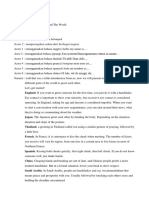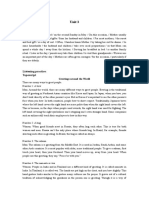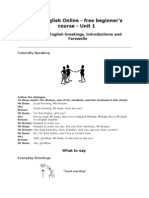0% found this document useful (0 votes)
629 views3 pagesCultural Greetings for Students
This document lists traditional greetings from many different cultures around the world. Some cultures greet with a handshake, others kiss cheeks in different patterns, some press noses or bow. Greetings vary from "Hello" to specific phrases with different meanings depending on factors like the person's gender or status. The purpose is to introduce students to cultural diversity in greetings globally.
Uploaded by
maymontanoCopyright
© Attribution Non-Commercial (BY-NC)
We take content rights seriously. If you suspect this is your content, claim it here.
Available Formats
Download as DOC, PDF, TXT or read online on Scribd
0% found this document useful (0 votes)
629 views3 pagesCultural Greetings for Students
This document lists traditional greetings from many different cultures around the world. Some cultures greet with a handshake, others kiss cheeks in different patterns, some press noses or bow. Greetings vary from "Hello" to specific phrases with different meanings depending on factors like the person's gender or status. The purpose is to introduce students to cultural diversity in greetings globally.
Uploaded by
maymontanoCopyright
© Attribution Non-Commercial (BY-NC)
We take content rights seriously. If you suspect this is your content, claim it here.
Available Formats
Download as DOC, PDF, TXT or read online on Scribd
/ 3





















































































